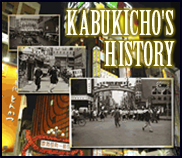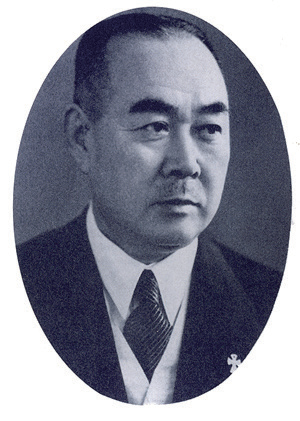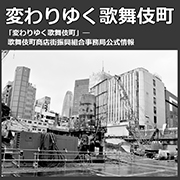
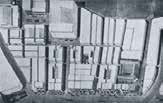
- The Kabukicho Planning Diagram
Thanks to the work of Kihei Suzuki, construction plans for theaters and cinemas, performance arenas, and dance halls for kabuki performances were created, and construction was just beginning when suddenly Emergency Financial Measure ordinances were rolled out, resulting in temporary construction restrictions and bank account closures. The plan became impossible to see through, and failed. At the time, only Chikyuza (which later became HUMAX) received permission for construction, and continued work. When it was completed, there were lines that went all the way to the station. Later, in 1950, Kabukicho announced itself as a candidate for the Tokyo Culture and Industry Exhibition, and an arena for the exhibition was constructed, and that pavilion became the basis for the current theater town. The exhibition progressed things in the direction intended by Kihei Suzuki, but the event itself was a massive failure. Kihei, who had over extended himself in selling his personal property, went bankrupt, and in the sudden wake of his loss of inf luence, a new source of inf luence arrived: Sakujiro Fujimori (the first chairman of the Kabukicho Shopping District Promotion Association). The Kabukicho Shopping District Promotion Association and the four entertainment companies (Toho, Tokyu Recreation, HUMAX, and Toa Koko) negotiated, and together made 1955 through 1975 an era of prosperity for Kabukicho.
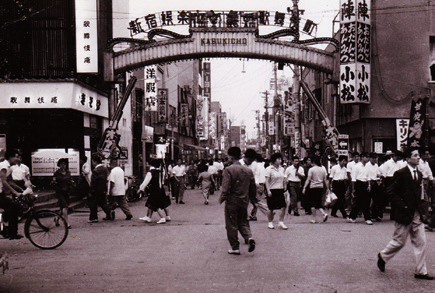
- The original arch, constructed in 1956 on Ichibangai, Gekijo Dori.
The liveliness of the nights there quieted, and cinemas slowly lost the ability to operate all night, which destroyed the economic structure of late nights there, and drastically decreased the sales in restaurants. The number of people visiting the red light district on the other hand increased, making large changes in the balance of Kabukicho as a business district. The cabaret club boom began after 1965, and as Heisei began, out of store services (“delivery health”, etc.) increased, which brings us to our current host club bubble.
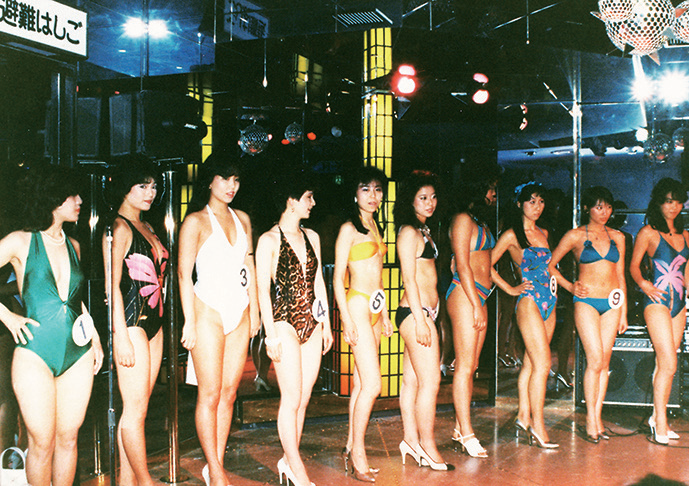
- The cabaret club Shinjuku Cats was created in 1964. This was also when the term cabaret club was coined. It turned the convent ional not ion of professionals of fer ing such services on its head, and al lowed amateur universit y students to work with clients, to massive popularity. This was fol lowed by a mas s ive increas e in establ i shment s cal l ing themselves cabaret clubs, and became a new genre in the food services industry.
Hideaki Ishikawa once said, “A town is its people.”
Text/Kouichi Teratani
HISTORY OF KABUKICHO
| year | month | description |
|---|---|---|
| 1945 | 4,5 | The entire area is burned by the air strikes in April/May |
| 10 | Reconstruction Cooperation Association (Chairman: Kihei Suzuki) established;land reorganization begins | |
| 1947 | 12 | Land reorganization complete |
| 1948 | 4 | Kabukicho is born on April 1st |
| 7 | The Entertainment and Amusement Trades Control Act comes into effect | |
| 1949 | 4 | Final Metropolitan train station moves from O-dori to Kabukicho |
| 4 | The Kabukicho Promotion Association begins (town council and business association) | |
| 1950 | -6 | Culture and Industry Exhibition |
| 1951 | 1 | The Shinjuku Ward Office moves from Ushikome to Kabukicho |
| 1952 | 3 | The Seibu Shinjuku Station opens |
| 1956 | 12 | The Shunjuku Tokyu Bunka Kaikan is completed on the 1st |
| The Shinjuku Koma Theater is completed on the 28th | ||
| The Kabukicho Promotion Cooperative is formed | ||
| 1963 | 6 | The Kabukicho Shopping District Promotion Association is formed |
| 11 | The Toden Suginami Line closes (began in October 1921) | |
| 1964 | 1 | Kabukicho’s first coming of age ceremony is held |
| 2 | Kabukicho Benzaiten’s first bean showering ceremony is held | |
| 5 | The Japanese Nation Railway’s Shinjuku Minshu Station is opened | |
| 10 | The Tokyo Olympics are held | |
| 1965 | 10 | The population moving through the city between 10am and 10pm reaches 154,000 |
| 1967 | 1 | Kihei Suzuki’s funeral is held by the Kabukicho Association |
| 1968 | 7 | The postal code system is implemented |
| 10 | The Kabukicho Crime Prevention Demonstration is held | |
| The Shinjuku student riots are held on International Anti-War day | ||
| 1969 | The arch in Gekijo-dori 1-bangai is completed. | |
| 10 | The Shinjuku Police Department is opened (formerly the Yodobashi Police Department) | |
| 1970 | 3 | Toden disappears from Kabukicho |
| 1972 | 11 | The population moving through the city between 10am and 10pm reaches 260,000 |
| 1973 | 9 | The Subnade underground shopping district and parking lot is completed |
| The Chuo-dori entrance scramble interchange is completed | ||
| 1975 | 4 | The Shinjuku Fire Department opens (formerly the Yodobashi Fire Department) |
| 1977 | 3 | The Seibu Shinjuku Station Building is created (made using the station building) |
| 1978 | 7 | Kabukicho is changed into Kabukicho 1-chome |
| 1979 | 3 | Central Road (formerly Chuo-dori) is completed |
| 1980 | 10 | The first Shinjuku Ward Festival is held |
| 11 | American Boulevard is opened | |
| 1981 | 8 | The first Kabukicho Furusato Festival is held |
| 11 | The population moving through the city between 10am and 12am reaches 270,000 | |
| 1985 | 2/13 | The Businesses Affecting Public Morals Regulation Act comes into effect |
| 1987 | 7 | The Shinjuku Tax Department is opened (formerly the Yodobashi Tax Department) |
| 8 | The Okubo Hospital closes temporarily (construction of the Metropolitan Health Plaza Hygeia begins) | |
| 1993 | 4 | Construction on Metropolitan Health Plaza Hygeia finishes |
| 1998 | 5 | Amendments to the Businesses Affecting Public Morals Regulation Act comes into effect |
| 1999 | 1 | The Euro is born |
| 2001 | 4 | The Koizumi Administration begins |
| 9/1 | The Kabukicho building fire results in 44 deaths | |
| 2002 | 7 | The first Shinjuku Eisa Festival is held |
| 2004 | The Korean boom arrives | |
| 2005 | 1 | The Kabukicho Renaissance Promotion Committee is created |
| 2006 | 5 | Amendments to the Businesses Affecting Public Morals Regulation Act comes into effect come into effect |
| 2008 | 11 | The Ward Office avenue illumination project begins |
| 2011 | 12 | The Shinjuku Koma Theater/Shinjuku Toho building is closed |
| 3/11 | The East Japan Great Earthquake hits Japan | |
| 2013 | 4 | The Kabukicho temporary police box, known as the Safety Station, opens |
| 9 | The Shinjuku Ordinance on the Prohibition of Solicitation in Public Spaces comes into effect | |
| 12 | LED renovations on the Gekijo-dori 1-bangai Arch are completed | |
| 2014 | 2 | The Kabukicho Concierge Committee is formed |
| 12 | The Shinjuku TOKYU MILANO Building “Milanoza” closes | |
| 2015 | 3 | The New Central Road (with new street and traffic lights, etc.) is completed |
| 4 | The Hotel Gracery Shinjuku opens in the Shinjuku Toho Building | |
| 2016 | 3 | The Cinecity Plaza construction project is completed |
| 11 | The Kabukicho Shopping District Promotion Association building demolition begins | |
| 12 | Sauna Green Plaza closes (sold to Tokyu) | |
| 2018 | 5 | Construction of the Kabukicho Shopping District Promotion Association building is completed |
| 2020 | 8 | The Tokyo Olympics/Paralympics are held |
| 2022 | 8 | Scheduled completion of the new Shinjuku TOKYO MILANO building (48 floors, 225m in height) |














